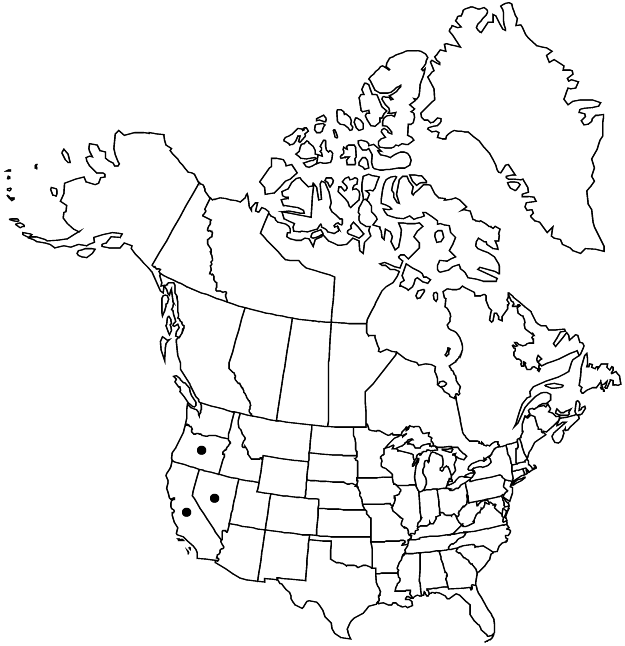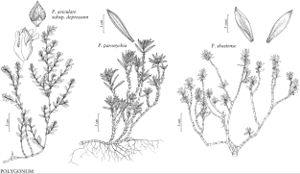Difference between revisions of "Polygonum shastense"
Proc. Amer. Acad. Arts 8: 400. 1872.
FNA>Volume Importer |
imported>Volume Importer |
||
| (6 intermediate revisions by 2 users not shown) | |||
| Line 8: | Line 8: | ||
}} | }} | ||
|common_names=Shasta knotweed | |common_names=Shasta knotweed | ||
| + | |special_status={{Treatment/ID/Special_status | ||
| + | |code=F | ||
| + | |label=Illustrated | ||
| + | }}{{Treatment/ID/Special_status | ||
| + | |code=E | ||
| + | |label=Endemic | ||
| + | }} | ||
|basionyms= | |basionyms= | ||
|synonyms= | |synonyms= | ||
| Line 24: | Line 31: | ||
|elevation=2100-3400 m | |elevation=2100-3400 m | ||
|distribution=Calif.;Nev.;Oreg. | |distribution=Calif.;Nev.;Oreg. | ||
| − | |discussion=<p>Polygonum shastense may be cultivated in rock gardens in rock crevices with favorable water regime and shaded in summer.</p> | + | |discussion=<p><i>Polygonum shastense</i> may be cultivated in rock gardens in rock crevices with favorable water regime and shaded in summer.</p> |
|tables= | |tables= | ||
|references= | |references= | ||
| Line 33: | Line 40: | ||
-->{{#Taxon: | -->{{#Taxon: | ||
name=Polygonum shastense | name=Polygonum shastense | ||
| − | |||
|authority=W. H. Brewer | |authority=W. H. Brewer | ||
|rank=species | |rank=species | ||
| Line 47: | Line 53: | ||
|publication title=Proc. Amer. Acad. Arts | |publication title=Proc. Amer. Acad. Arts | ||
|publication year=1872 | |publication year=1872 | ||
| − | |special status= | + | |special status=Illustrated;Endemic |
| − | |source xml=https:// | + | |source xml=https://bitbucket.org/aafc-mbb/fna-data-curation/src/2e0870ddd59836b60bcf96646a41e87ea5a5943a/coarse_grained_fna_xml/V5/V5_1147.xml |
|subfamily=Polygonaceae subfam. Polygonoideae | |subfamily=Polygonaceae subfam. Polygonoideae | ||
|genus=Polygonum | |genus=Polygonum | ||
Latest revision as of 23:08, 5 November 2020
Subshrubs. Stems prostrate to ascending, brown, branched, gnarled, not wiry, 5–40 cm, glabrous. Leaves ± uniformly distributed, articulated to ocreae, basal leaves caducous or persistent, distal leaves not reduced in size; ocrea 3–5 mm, glabrous, proximal part cylindric, distal part membranous, deciduous with leaves; petiole 0–0.5 mm; blade 1-veined, without pleats, lanceolate to elliptic, 5–25 × 2–5 mm, coriaceous, margins revolute, smooth, apex acute. Inflorescences axillary; cymes in distal axils, 2–6-flowered. Pedicels enclosed in or slightly exserted from ocreae, erect, 2–4 mm. Flowers open or semi-open; perianth 5–9 mm; tube 7–15% of perianth length, tepals partially overlapping, uniformly pink or white, petaloid, ovate to ovate-round, apex rounded; midveins with numerous branched lateral veins; stamens 8. Achenes enclosed in or slightly exserted from perianth, brown, narrowly ovate, 3–4 mm, faces subequal, shiny, smooth.
Phenology: Flowering Jul–Sep.
Habitat: Rocky or gravelly slopes
Elevation: 2100-3400 m
Distribution

Calif., Nev., Oreg.
Discussion
Polygonum shastense may be cultivated in rock gardens in rock crevices with favorable water regime and shaded in summer.
Selected References
None.
